(via TheNewswire)
Vancouver, British Columbia – TheNewswire - November 16, 2023 – Rackla Metals Inc. (TSXV:RAK) (the “Company”) is pleased to announce that the Company has received the final geochemical analyses from the 2023 exploration program on its properties in the Astro Plutonic Complex.
These results include analyses for drill core from the 17-hole, 3,000 m drill program, rock, soil and stream sediment samples from the three properties in the Astro Intrusive Complex and interpretation of the results.
The Astro Plutonic Complex is located within the Tombstone Gold Belt at the Yukon-NWT border and is accessible from the North Canol road. The Complex includes three granodiorite to granite intrusions belonging to the Cretaceous-aged Tombstone & Tungsten Suites. Cretaceous intrusions in the Tombstone Gold Belt host significant Reduced Intrusion-Related Gold System (RIRGS) gold deposits such as the Fort Knox Mine in Alaska (12.1 Moz gold), the Eagle Mine in Yukon (7.8 Moz gold) and the newly discovered Valley gold occurrence belonging to Snowline Gold Corp.
Figure 1: Astro Plutonic Complex.
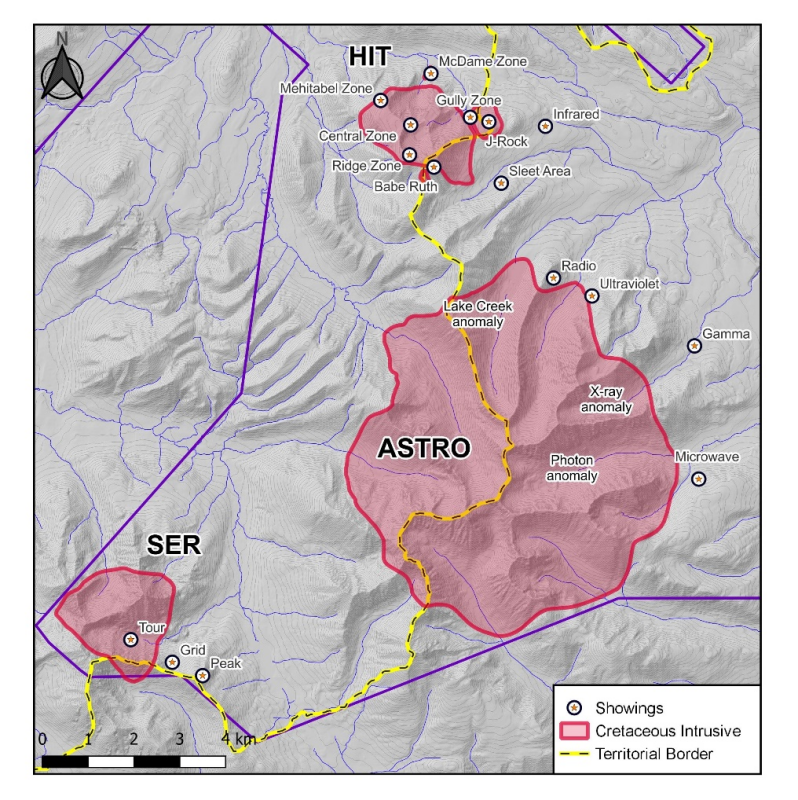
Click Image To View Full Size
Astro Property
The Astro property is centered around the Border Pluton, a granodiorite intrusion belonging to the Cretaceous-aged Tombstone Suite. The pluton measures 6.7 by 7.0 km and has an intensely metasomatized contact aureole around its margins, typical of gold-bearing Tombstone Gold Belt occurrences. Prior exploration has identified 5 gold-bearing skarn occurrences along the margins of the intrusion in the hornfels contact aureole (the Radio, Ultraviolet, Microwave, Gamma and Infrared occurrences). Stream sediment, soil, talus and rock sampling on the property has returned numerous samples containing anomalous gold with a strong correlation with bismuth, tellurium, arsenic and tungsten. This chemical association has led Rackla to believe that the mineralizing system at Astro is related to a RIRGS.
The 2023 exploration season was Rackla’s first on the property. Rackla completed a comprehensive program including stream sediment, soil, talus and rock sampling, prospecting, geological mapping, airborne and ground geophysics and diamond drilling. This first pass exploration program by the Company has been successful in refining the understanding of three of the previously identified occurrences (Radio, Ultraviolet and Microwave) and identified 3 new targets within the intrusion: the Lake Creek, X-ray and Photon occurrences.
The drill program was primarily focused on the Radio-Ultraviolet target areas, where 10 of the 12 holes were drilled. The two remaining holes were drilled on the Lake Creek target.
The exploration program on the Radio and Ultraviolet targets defined a gold-arsenic talus-fine geochemical anomaly that measures 750 x 450 m in the valley between the two occurrences. This anomaly is open to the south. Six drill holes tested this anomaly (AST-001, -003, -004, -006, -007, and -008). The best results from the drilling were hole AST-004 (34.12 m @ 0.261 g/t Au) and hole AST-007 (3.05 m @ 3.465 g/t Au with 4174 ppm As). Exploration in the Radio-Ultraviolet valley has returned a large area with significantly anomalous gold in soil samples and rock samples. The Company is of the opinion that the 2023 drill results do not fully explain the source of these gold anomalies and believes that more work is required to understand the anomalies.
At the Radio skarn, the Company conducted prospecting, geological mapping, rock sampling, ground magnetic and electromagnetic surveys and drilled 3 holes (AST-002, -005 and 011): AST-002 was lost in a fault zone before hitting the target; AST-005 intersected 12.44 m @ 0.492 g/t Au with 551 ppm Bi and 534 ppm Cu; and hole AST-011 intersected 1.50 m @ 0.530 g/t Au with 21 ppm Bi. The ground geophysical survey identified a large coincident magnetic and conductive anomaly east and north of the Radio drill holes. The northern part of this geophysical anomaly, on the west side of the Radio target ridge, is coincident with a soil geochemical gold anomaly. The Company plans to focus exploration on this target in 2024 to define it further, followed by drilling.
At the Ultraviolet target, Rackla conducted prospecting, geological mapping, rock sampling, ground magnetic and electromagnetic surveys and drilled one hole (AST-009). The geophysical survey defined a small magnetic body indicating that the target may be limited in size. Hole AST-009 returned a single intercept of 1.53 m containing 0.44 g/t gold with 62 ppm bismuth. No further work is planned on this target at this time.
The Lake Creek occurrence is defined by a talus sample bismuth anomaly that measures 2.0 x 0.4 km in the valley bottom where prospecting has returned up to 2.38 g/t Au in rock samples. The prospecting program also identified a significant density of sheeted quartz-sulphide veins in the granodiorite that were variably mineralized. Drill hole AST-010 did not return any significant intercepts, but hole AST-012, drilled further up the valley, returned six narrow intervals (1.5 m each) over a 140 m total width with gold values between 0.11 and 0.37 g/t. These gold-bearing intercepts had associated anomalous bismuth and arsenic up to 22 ppm and 973 ppm, respectively. Further work is required in this area to determine if there is a higher-grade source to the talus-fine anomaly.
The X-ray anomaly is defined by a series of anomalous gold-in-stream sediment anomalies, a gold-in-talus anomaly, rock samples that returned up to 2.5 g/t gold and the observation of sheeted quartz-sulphide veins. Only a limited amount of work was conducted in the area and more work is planned for 2024 on this target to define it further.
The Photon anomaly is in the valley south of the X-ray anomaly and northwest of the Gamma skarn. Photon has only had a minor amount of work, consisting of stream sediment sampling and prospecting. The stream sediment sampling returned moderately anomalous gold values with coincident bismuth and arsenic. A large 3m boulder located in the creek with sheeted quartz/sulfide veining returned results of 4.6 g/t gold with 2690 ppm bismuth. This was late in the season but clearly more work is planned to follow-up on these results in 2024.
Rackla is encouraged by these results, particularly because the coincidence of bismuth and arsenic with the gold corroborates the belief that the mineralizing system at Astro is caused by a RIRGS system. The Company plans to do more work on the property in 2024 to further refine these targets and determine if there is a significant mineralizing centre at Astro.
Figure 2: Astro Property compilation map with 2023 drill hole locations.
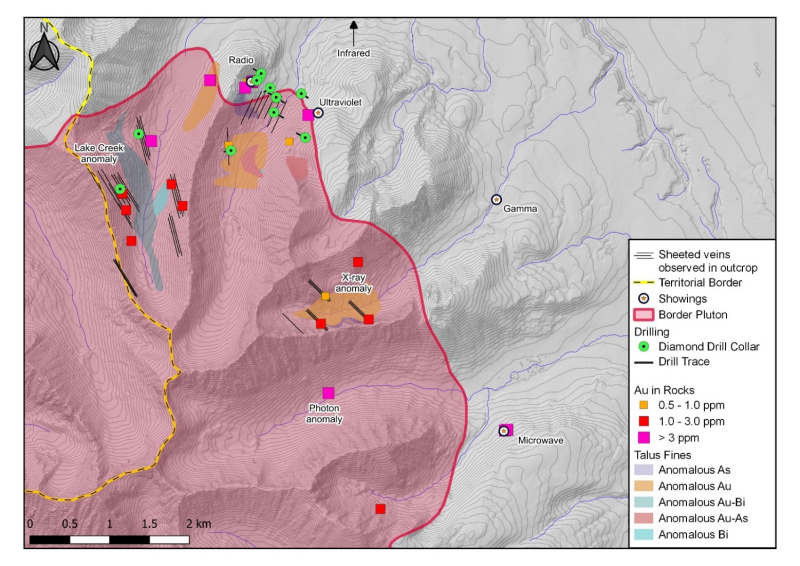
Click Image To View Full Size
SER Property
The SER property covers the Kelvin Stock, a biotite-hornblende-clinopyroxene granite belonging to the Tombstone Suite. The granite intrudes and alters sedimentary rocks and like the other intrusions in the Complex, has a prominent metasomatized contact aureole.
Three mineral occurrences have been identified on the property: the Tour Zone, the Grid Zone and the Peak Zone. The Tour Zone contains abundant sheeted quartz-tourmaline-scheelite veins along with a Au-Bi-As soil anomaly, the Grid Zone is defined by a strong Au-As soil anomaly and numerous high gold-arsenic rock samples, and the Peak Zone has an anomalous Au-Bi soil anomaly with a few anomalous gold-in-rock samples. Prospecting and rock sampling have returned a considerable number of samples that contain greater than 0.5 g/t gold, with 22% of the samples above 0.5 g/t gold and a peak value of 27.5 g/t gold. The chemistry of the anomalous gold-in-rock samples shows a strong correlation to arsenic and bismuth.
Talus-fine sampling has also identified an area of anomalous bismuth at the head of the valley. The SER property has not yet been drill tested.
Figure 3: SER Property compilation map.
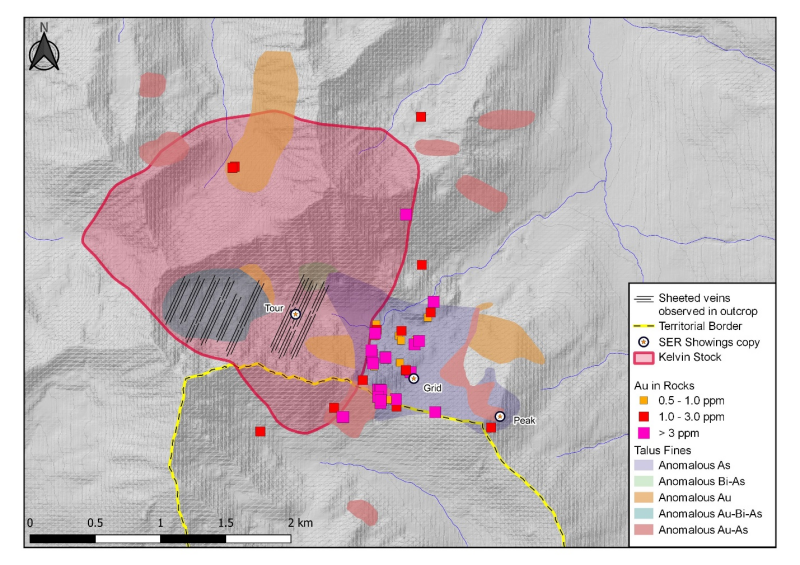
Click Image To View Full Size
HIT Property
The HIT property is centered around the Canol Trail Stock, a monzogranite intrusion belonging to the Cretaceous-aged Tungsten Suite. Rackla completed a comprehensive program at HIT in 2023, including stream sediment, soil, talus and rock sampling, prospecting, geological mapping, airborne geophysics and drilled 997 m in 5 holes on the property. The results of the drill program included 129.8 m grading 0.248 g/t gold in hole HIT-003 and 45.5 m grading 0.516 g/t gold in HIT-004 (October 31, 2023 press release). Both intercepts had a strong correlation with bismuth and arsenic.
Figure 4: HIT Property drill holes HIT-003 and -004 cross section with gold intercepts and density of sheeted veins.
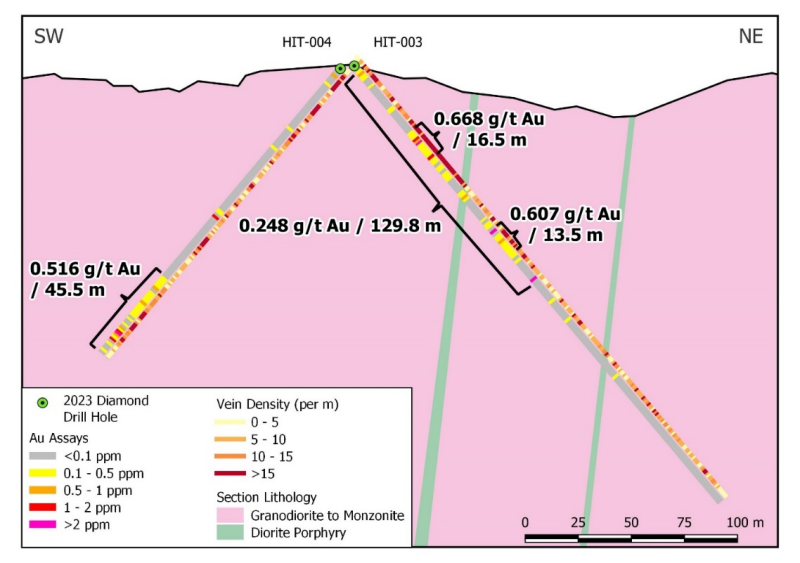
Click Image To View Full Size
Figure 5: HIT Property drill holes HIT-003 and -004 cross section with gold, bismuth, tungsten, tellurium and arsenic.
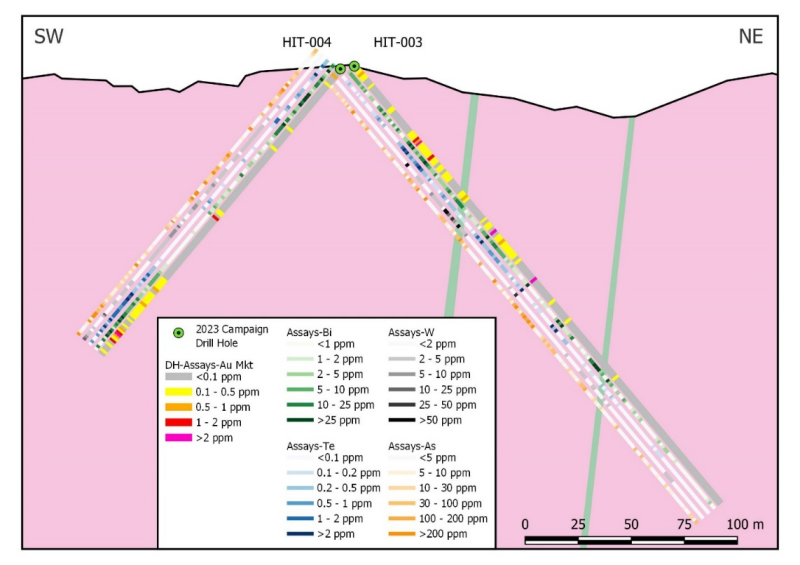
Click Image To View Full Size
The soil and talus fine sampling program at HIT defined a large gold-bismuth-arsenic anomaly to the west of drill holes HIT-003 and HIT-004. This anomaly is open to the south and north. Prospecting and rock sampling at HIT has returned 11% of the samples containing greater than 0.5 g/t gold (45 samples > 0.5 g/t Au), with the highest value being 26.5 g/t gold. There is a strong correlation between gold, bismuth, tellurium and arsenic in rock and drill core samples.
Figure 6: HIT Property compilation map.
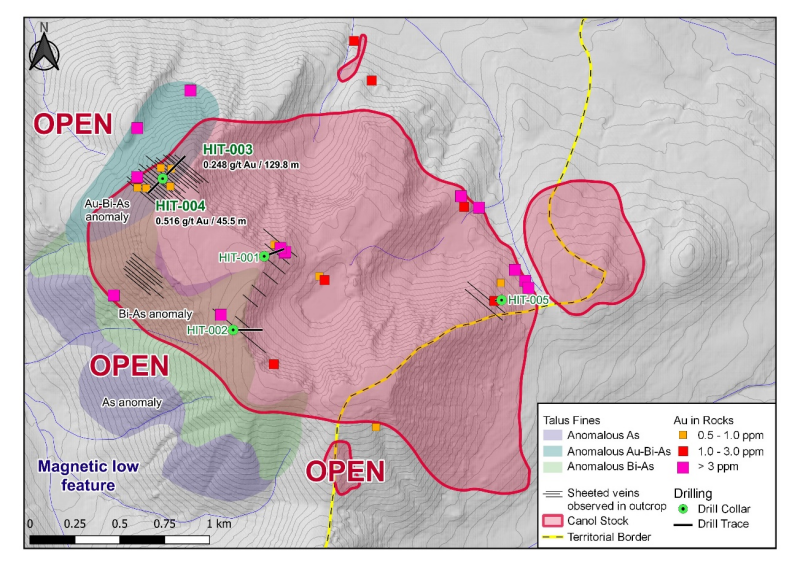
Click Image To View Full Size
Rackla is encouraged by the results of their first summer of exploration in the Astro Intrusive Complex. The geological crew worked hard to become familiar with the geological characteristics of each of the three intrusions and to ground truth the significant historical geological and geochemical dataset. The Company continues to believe that each of the three intrusions has the potential to host significant RIRGS mineralization and the crew is excited to get back on site in 2024 to follow up on these promising results.
Simon Ridgway, Rackla Metals CEO, commented: “ The team and I personally are excited by the potential indicated by the drilling at the Astro Intrusive Complex. Holes HIT-003 and HIT-004 are certainly indicating the presence of a RIR Gold System at the Canol Trail Stock. A much larger drill program will be planned for next year to follow up this discovery, and we will continue the boots on the ground exploration of the other properties that the Company now 100% owns.”
Analytical Procedure
Drilling was generally performed with NQ2-sized equipment. Occasionally drill holes were collared with HQ2-sized equipment if ground conditions were difficult. Drill core was systematically logged for geological attributes, photographed and sample intervals identified by a geologist at Rackla’s field camp. Samples were generally sampled at 1.5 m intervals, but occasionally shorter intervals were sampled to isolate features of interest. Samples were collected by cutting the core in half along the axis of the core. Field duplicates were collected at regular intervals by cutting the half core to be sent to the lab into two ¼ core samples, each with unique sample numbers leaving a consistent record of half core material in the core box. Standard reference materials were inserted by Rackla personnel at regular intervals into the sample stream. Samples were delivered by expeditor to ALS Global preparatory facility in Whitehorse, Yukon. Sample preparation was completed in Whitehorse, with analyses completed in North Vancouver, BC. ALS Global is an accredited ISO/IEC 17025 and ISO9001 laboratory for quality management.
At the lab, drill core samples were crushed by ALS to >75% passing below 2 mm and split using a riffle splitter. 250 g splits were pulverized to >85% passing below 75 microns. 0.5 g of the sample pulps were digested with aqua regia and analyzed by an inductively coupled plasma mass spectroscopy and inductively coupled plasma atomic absorption spectroscopy (ICP-MS+ICP-AES) finish for 51-element analysis (ALS code: ME-MS41). All samples were analysed for gold content by fire assay with a gravimetric finish on 50 g samples (ALS code: Au-GRA22).
For the purposes of this release, mineralized intervals are defined as runs of mineralization >0.1 g/t Au.
Qu alified Person
Scott Casselman, B.Sc., P.Geo., Vice-President Exploration of the Company, is a member of the Association of Professional Engineers and Geoscientists of British Columbia and is the Company’s Qualified Person as defined by National Instrument 43-101. Mr. Casselman has reviewed and approved the technical information contained in this news release.
About Rackla
Rackla Metals Inc. (TSX-V: RAK) is a Vancouver, Canada based junior gold exploration company. The Company is targeting Reduced Intrusion-Related Gold Systems (RIRGS) mineralization on the southeastern part of the Tombstone Gold Belt in eastern Yukon and western Northwest Territories. Management believes that this area, which is underexplored for RIRGS deposit types, has the potential to be the next frontier for their discovery.
ON BEHALF OF THE BOARD
Simon Ridgway,
CEO and Director
Tel: (604) 801-5432; Fax: (604) 662-8829
Email: info@goldgroup.com
Website: www.racklametals.com
Neither the TSX Venture Exchange nor its Regulation Services Provider (as that term is defined in the policies of the TSX Venture Exchange) accept responsibility for the adequacy or accuracy of this press release.
Forward-Looking Information
Certain statements contained in this news release constitute forward-looking statements within the meaning of Canadian securities legislation. All statements included herein, other than statements of historical fact, are forward- looking statements and include, without limitation, statements about the Company’s proposed exploration activities. Often, but not always, these forward looking statements can be identified by the use of words such as “estimate”, “estimates”, “estimated”, “potential”, “open”, “future”, “assumed”, “projected”, “used”, “detailed”, “has been”, “gain”, “upgraded”, “offset”, “limited”, “contained”, “reflecting”, “containing”, “remaining”, “to be”, “periodically”, or statements that events, “could” or “should” occur or be achieved and similar expressions, including negative variations.
Forward-looking statements involve known and unknown risks, uncertainties and other factors which may cause the actual results, performance or achievements of the Company to be materially different from any results, performance or achievements expressed or implied by forward-looking statements. Such uncertainties and factors include, among others, changes in general economic conditions and financial markets; the Company or any joint venture partner not having the financial ability to meet its exploration and development goals; risks associated with the results of exploration and development activities, estimation of mineral resources and the geology, grade and continuity of mineral deposits; unanticipated costs and expenses; and such other risks detailed from time to time in the Company’s quarterly and annual filings with securities regulators and available under the Company’s profile on SEDAR at www.sedar.com. Although the Company has attempted to identify important factors that could cause actual actions, events or results to differ materially from those described in forward-looking statements, there may be other factors that cause actions, events or results to differ from those anticipated, estimated or intended.
Forward-looking statements contained herein are based on the assumptions, beliefs, expectations and opinions of management, including but not limited to: that the Company’s stated goals and planned exploration activities at its properties will be achieved; that there will be no material adverse change affecting the Company or its properties; and such other assumptions as set out herein. Forward-looking statements are made as of the date hereof and the Company disclaims any obligation to update any forward-looking statements, whether as a result of new information, future events or results or otherwise, except as required by law. There can be no assurance that forward-looking statements will prove to be accurate, as actual results and future events could differ materially from those anticipated in such statements. Accordingly, investors should not place undue reliance on forward-looking statements.
Copyright (c) 2023 TheNewswire - All rights reserved.
© 2024 Canjex Publishing Ltd. All rights reserved.